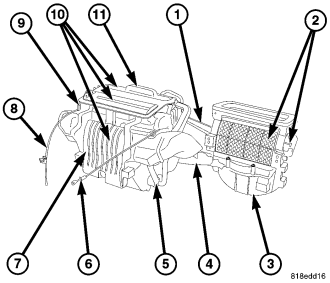
A manual temperature control (MTC) single zone type heating-A/C system or a manually controlled heater-only system is standard equipment on this model, depending on market.
To maintain the performance level of the heating, ventilation and air conditioning (HVAC) system, the engine cooling system must be properly maintained. The use of a bug screen is not recommended. Any obstructions in front of the radiator or A/C condenser will reduce the performance of the A/C and engine cooling systems.
The engine cooling system includes the radiator, thermostat, radiator hoses and the engine coolant pump. Refer to 7 - Cooling for more information before opening or attempting any service to the engine cooling system.

All vehicles are equipped with a common heater, ventilation and air conditioning (HVAC) housing (1). The heating-A/C system combines A/C, heating, and ventilating capabilities in a single HVAC housing mounted within the passenger compartment beneath the instrument panel. The HVAC housing includes:
On heater-only systems, the A/C evaporator is omitted from the HVAC housing and is replaced with an air restrictor plate.
NOTE: An electric positive temperature coefficient (PTC) heater is used on vehicles when equipped with the 2.8L diesel engine. The PTC heater unit compensates for the lower engine coolant temperatures produced by the diesel engine. The PTC heater unit is mounted in the HVAC air distribution housing, downstream of the heater core. For more information, (refer to 24 - HEATING & AIR CONDITIONING/CABIN HEATER/HEATER UNIT - DESCRIPTION).
Based upon the system mode selected, conditioned air can exit the standard heater-only or optional heater-A/C housing through one or a combination of the three main housing outlets: defrost, panel or floor. The defrost and panel outlets are located on the top of the HVAC air distribution housing and the floor outlets are located on each side of the distribution housing. Once the conditioned air exits the HVAC housing, it is further directed through molded plastic ducts to the various outlets within the vehicle interior. These outlets and their locations are as follows: